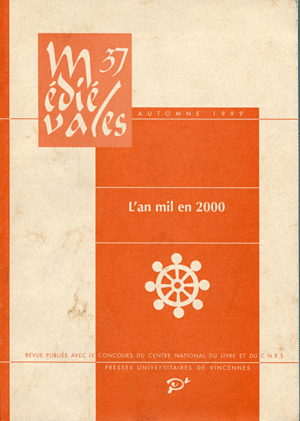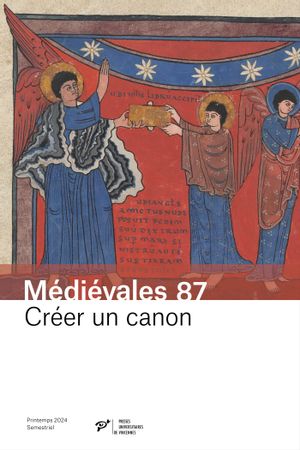Patrick J. GEARY, Richard LANDES, Amy G. REMENSNYDER, Timothy REUTER, Barbara H. ROSENWEIN : « Who’s afraid of the Year 1000 ? An E-mail Debate at the Approach of 2000 »
A debate conducted via e-mail among four Anglophone medievalists. The discussion focuses largely on the interpretation of four key texts : a charter from the cartulary of St.-Victor, a portion of the Apologeticus by Abbo of Fleury ; passages from the Chronicon by Thietmar of Merseburg and De ortu et tempore Antichristi by Adso of Montier-en-Der. The discussants reveal radically different interpretative strategies in their reading and assessment of these sources. In the final portion of the debate, the participants address the complex issue of generalization : to what degree can we generalize geographically across regions and socially across classes ?
Dominique BARTHÉLEMY : « Antichrist and Blasphemer »
Bernard d’Angers (I. 12) uses the invective “antichrist” to designate a lord making a claim for property against Sainte-Foy of Conques. He terms “blasphemer” a vassal who staunchly defends the lord, thus making the divine vengence more expressive and deserved. Using sources such as biased and coded chronicles and hagiographies, some historians tend to render the year 1000 too dramatic. Their illusions, encouraged by Michelet and Duby, should henceforth give way to a more authentic history.
Guy LOBRICHON : « Judgment on Earth as in Heaven. The Strange Case of the Millennial Apocalypse of Bamberg »
The famous illustration of the Last Judgment in the Apocalypse of Bamberg (Staatliche Bibliothek, Bibl. 140 (A. II.42) f° 53 r°), though frequently cited by art historians, has not been a subject much written about. The main problem, as we know, consists in the dating of the manuscript, circa 1010-1020, or 1000. The propositions enumerated in this article directly implicate the young emperor Otto III and his entourage.
Pierre BONNASSIE : « Les inconstances de l’An Mil »
The year 1000 is an uncertain age, an intervening period where the old and the new inextricably mix, giving rise to contradictions in the sources, which often present antithetical views. Far from accepting these as the signs of the contrasts of the times, too many historians today tend to doubt the evidence and to offer a smooth, even antiquated image of 1000. Without going so far as to paint an apocalyptic picture of the year 1000, its fascinating originality deserves to be preserved.
Dominique IOGNA-PRAT : « Consistencies and Inconsistencies of the Year 1000 »
In response to the e-mail debate summarized in this issue and under a slightly provocative title, this rapid survey attempts to take the measure of our collective inconsistencies in the face of a problem which will remain murky as long as we do not address it in its entirety : as a historical concretion which should be considered in the context, but also as the vision of a past shaped by slow stratification which deserves to be studied in its own right if we are to begin to acquire an autonomy of thought.
Stephen D. WHITE : « Rethinking Violence : From 2000 to 1000 »
For the purpose of re-thinking questions about violence at the turn of the first millennium in the light of theoretical debates about violence as we approach 2000, this paper briefly considers not only the public physical violence of lay lords and knights, but also various forms of monastic violence, including verbal and ritual violence supposedly used by supernatural beings to avenge injuries to monks. By situating these different forms of lay and monastic violence in a culturally constructed game of feuding, in which the use of violence and the representation of an enemy’s alleged violence were both recognized moves, the paper poses the question of whether this kind of political game and the entire feuding culture constituting it could have been rapidly created at the turn of the first millennium by local lords and knights suddenly freed from state control or whether monks as well as lay people constructed them more slowly by gradually adapting older political practices and pre-existing cultural categories.
Sophia BOESCH-GAJANO : « Religious Anguish and Existential Anguish At the Turn of the Millenniums »
The emphasis put on the years 1000 and 2000 leads to reflect upon the conception of time, upon the importance of controlling and measuring it in the Christian civilization. Whereas the passage from the first to the second millennium was a post eventum construction by an ecclesiastical historiography, the passage from the second to the third is constructed in the present, favored by the actual technological possibilities of measuring time and by the worldwide dissemination of information. In the Roman Catholic Church, John Paul II has marked the passage by proclaiming a Jubilee, in continuity with the centuries-old scansion invented in 1300 (later accelerated). Both passages are cultural constructions bearing a strong symbolic meaning : the first constructed by ideology and historiography, the second by ideology and technology.
Robert DELORT : « Environment and Millenniums »
The environment has changed in ten centuries, particularly according to our modern scientific standards, yet our perception of nature in many respects is still influenced by attitudes shaped in the Middle Ages. The environmental changes are due to geophysical and chemical factors (the influence of the galaxies, the sun, magnetism, tectonics, volcanic activity, earthquakes ; the climate, glaciation, sea levels, storm waves), or to bio-ecological factors (vegetation, fauna, micro-fauna, demography…). But the natural variations are interpreted by mankind and often modified in their forms or their consequences by agriculture, great construction works and town and country planning – and also by pollution, emerging diseases, new attitudes.
Jean-Christophe CASSARD : « Clovis ? Who’s he ? A Figure of Renown Missing from Breton Historiography »
The great figure of Clovis does not appear in Breton historiography until the later Middle Ages, and then only discreetly. The reasons for this neglect may be objective and historical – his lack of interest in the Peninsula – but above all political : in their common efforts to safeguard the liberties of the Duchy, its historians chose to exult the legendary figure of King Arthur – Breton sovereign, a Christian and a prestigious conqueror – instead of Clovis, cast into the shadows together with his Franks, latecomers to Gaul, as if to ensure a certain Breton pre-eminence founded on precedence in the faith and the glory of arms.
Étienne ANHEIM : « The Intellectual History of the Middle Ages, Between Social Practices and Doctrinal Debates »
The series Vestigia offers a collection of studies on medieval thought. Some of the works included are re-issues or translations of books in foreign languages and from medieval sources, but many are original texts ; syntheses as well as thematic studies. The main interest of the collection resides in its general project which aims to revive intellectual history by encouraging the dialogue between history and philosophy, and finally proposes an original method of confrontation between social or political stakes and doctrinal analysis.




